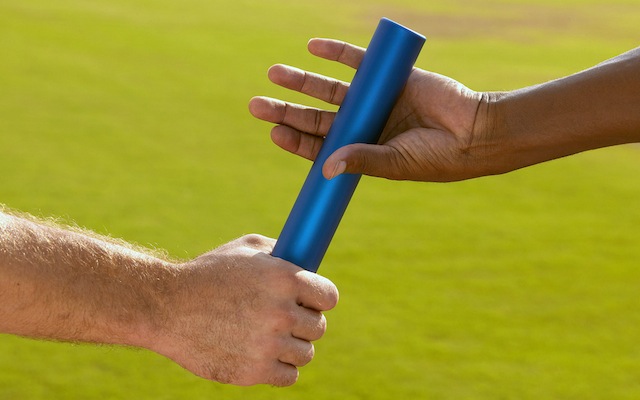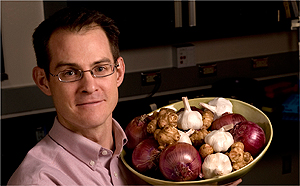“So if I’m getting an insulin test,” Suzie said, “then why do I also need these other things?”
I looked at the recommendations to get both proinsulin and C-peptides tested. “They both get at the question of your insulin production,” I said, “but it’s sort of like the difference between catching a ball with both eyes open, or with one eye shut. If you get all these tests, it’s like having both eyes open when you catch the ball. It gives you more perspective and a better way to figure out what’s going on. On the other hand, if you only get one of these tests, then it’s like trying to catch that ball with one eye squinted shut. You might not have enough perception then to catch it right.”
So we talked about Proinsulin and C-Peptide for a while, and with the technical explanations, really, none of it made much sense.
“This C-Peptide,” Suzie’s husband said, “Isn’t that a marker for inflammation.”
“No,” I said, sighing, and wishing that medical terminology could be more descriptive. “The marker for inflammation is C-Reactive Protein. C-Peptide, it does a different thing.”
Then I looked at the water bottles we had gotten with lunch, and they gave me an idea. “See these water bottles?” I said, and how they come to us with screwed on caps? Well, this whole water bottle, including the cap, is like the substance called “proinsulin.” The water inside is like the insulin. As for the cap, its role is similar to the role of a C-peptide.”
We went through it again, and on a second try, the analogy made more sense. “Proinsulin” is a big, complicated molecule that’s sort of like a wrapper, a cap AND the powerful hormone insulin, all together. C-Peptide is a sort of little protein cap that keeps the active insulin from spilling out. And in fact, it’s actually the cap AND the wrapper. I’m sure there’s some kind of squeezable juice bottle where once you drink it all, what’s left is a flimsy, empty box and cap that you scrunch together and then recycle. Well, that scrunchable box, including the cap, is actually more like a C-peptide. But we didn’t have a scrunchable box, so I was using the bottle. “So when the body actually needs insulin,” I said, then it unscrews the C-Peptide cap. The insulin pours into the bloodstream now like water pouring out of this bottle. As for the empty bottle and cap, now they go into the bloodstream, too. And we call that “empty” the C-peptide molecules. But until you remove the C-peptide from the insulin, it’s all one unit. It’s proinsulin.
This was an incredibly geeky thing to know. So why did I know it? Thianking back to a group I’d been in, where everybody got these tests, I remembered more about why knowing proinsulin matters. “Sometimes,” I told Suzie, it turns out that the body has lots of proinsulin around, but it has trouble taking off the C-peptide caps to get to the insulin.” I grabbed one of the water bottles that had an especially tightly sealed cap, and I couldn’t open it. It was embarrassing, but it also made the point, that the resource—the water, could be right there in front of us, but it was barred from use, as long as we couldn’t take off the cap.
The same really is true for insulin, I said. If the C-Peptide cap can’t be pulled away from the proinsulin, then you don’t get enough insulin. What’s more, this is certainly a sign of a stressed pancreas. That stress is a worry. But it’s also a clue that the Beta Cells in the pancreas which produce the insulin are not really dead. At least, not yet. There’s a chance that being extra gentle will help them revive more easily. It can give you a goal, to get your body healed enough that it can take off the C-Peptide caps.
“And how do I help my body heal?” she said.
“Probably by keeping your sugar levels as low as you possibly can. Definitely under 50 grams a day, at least for now. As for protein, to keep the stress level low, around 2 ounces a meal should be enough. That’s roughly 6 ounces for the ENTIRE day. Or if you have a gram counter, roughly 60 grams. And last, but very important, eat lots of fat. It’ll keep your fat-furnaces well stoked, it will keep you from craving sweets as much, and it’ll give your body even more reasons to heal because it rests it from dealing with as many sugars.
“What about supplements?” she asked.
“Well, there was an interesting situation in a group we did,” I said. It was a community study group where we had weekly lectures on health and ALSO a free supply of supplements. While most people really took to a low carb, adequate protein, high fat diet, there were two women who totally refused to do it. “I’m just going to take the supplements,” one woman said, and the other woman nodded her head.” So they didn’t change their eating habits, but they DID faithfully take their free supplements.
“And at the end of the study, guess how they did?” I asked Suzie and her husband.
“They got worse,” her husband said. Well, of course, they would!”
Well, yes and no,” I told them. You see, when they started the study, for both these women, their proinsulin levels had been very high, and their insulin levels had been very low. So they had plenty of sealed “bottles” of proinsulin. But not enough energy to take off the protein caps to let the insulin out. That was how they started the study.
“At the end of the study,” I said, their insulin levels had actually gone up! They were the only two people in the study group who saw their insulin levels rise instead of going down. And while their blood sugar levels went down a little, they didn’t go down as dramatically as people who had changed their diet.”
Suzie’s husband nodded his head. “So they remained fairly insulin resistant, but on the other hand, they had more insulin for handling it. And you think it might have been the supplements?”
That’s right,” I agreed. “It was like the supplements couldn’t make the cells more insulin sensitive, but it could give their pancreas enough oomph to take off the C-Peptide caps. I’m not a believer in taking supplements. But that data made me think that there might be something to it.”
We all looked at the water bottles with new appreciation. We spend a little while playing with putting on and off the water caps.
Then Suzie frowned and said, “Let me get this straight. I understand now why to get a test for insulin. And I understand why to get a test for proinulin, too, I think. But why also test for C-peptides? Why bother?”
“Well for one thing, our body actually needs some C-Peptides,” I said. C-peptides seem to make our artery walls stay more smooth and supple. They make it easier for our hearts to pump, and they help protect our nerve cells and the health of our kidneys. That’s worth knowing because injected insulin doesn’t have any C-peptide caps included. So if you’re low on natural insulin, you’re also low on C-Peptides. After all, for each bottle of water here, there’s only one cap. So if you’re short on natural insulin, you’re equally short on C-peptides.
“So, if C-Peptide is something that only your body produces,” Suzie said, “does that mean that it’s another way to check your natural insulin levels?”
“It is!” I replied. “In fact, some doctors like to check C-Peptides better than they like to check insulin, because C-peptides generally hang out in the bloodstream longer than insulin does. Insulin, the body’s trying to sweep around half of it out of the bloodstream, every 7 minutes. But C-peptides can hang aournd in the blood for more than an hour.”
I always consider that an interesting fact. That the body doesn’t LIKE stale insulin hanging out in the blood. Does it recycle it so fast because body’s like to be tidy? Or is it something about problems from stale insulin? Or that it’s so powerful, the body doesn’t want one smigeon of excess to be in the blood? There’s more lessons to know based on how the body handles insulin.
But right now, Suzie was excited about something else. “You mean, if they checked my C-peptide levels, it will tell me how much insulin my body produces?” She got our an I-phone from her purse and looked up her first test, where her blood sugars had been over 300 . . . “and my C-peptides were .7,” she said. “My doctor told me that that’s hardly even traceable.”
Her husband got out the paper copies of my lab results. He looked up, “Honey, her C-Peptide levels had only been .6. They were LOWER than yours. And still her blood sugar levels were only 80. While yours were 300 . . . with a higher C-Peptide level. Which means more insulin insulin.”
We looked at them more closely. The jury was still out, but this did seem to hint that Suzie’s cells had been somewhat insulin resistant. For if my body, on just a tiny bit of insulin could keep my blood sugars pretty normal, and Suzie’s body, with a tiny bit more of insulin had blood sugars over three times higher – – – well actually, her blood sugars had come down somewhat. They were more often around 120 or 150, with her own insulin stores plus 10 units that she injected, every morning. Hmmm. That roughly meant that her day’s supply of insulin was twice as high as mine. And yet her blood sugars were also 50% higher than mine tend to be. Which does hint that insulin resistance was at least part of what she was facing right now. And insulin resistance is easier to treat . . .
Suzie looked and looked, comparing our C-peptide numbers.






Very interesting, thank you for sharing the information!